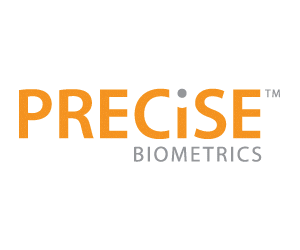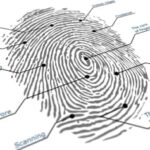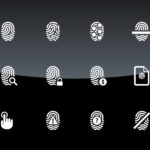Biometrics are a part of our everyday connected lives thanks to the mobile revolution that led to sensors and software being integrated into practically every smartphone device available on the market. In our 2017 Year in Review, our survey found that even among the professionals and executives we polled, the most common daily use for biometrics was to bypass a smartphone’s lockscreen. But mobile biometrics got their start in law enforcement, not the iPhone, and while smartphone access is the most popular use case at large, the technology is still transforming frontiers beyond the locked screen.
1. Securing Your Mobile Enterprise
 The rise of mobility created a multi-faceted vulnerability for enterprises, and in a growing climate of data breaches, biometrics are rising to the occasion. Businesses want biometrics so badly that many wish to turn to the biometric capabilities shipping on current generation smartphones, according to a new study from Gemalto. Of course, every mobile device offers its own biometrics, making a BYOD approach to workplace authentication based solely on native sensors an unmanageable nightmare. Thankfully, there are software options like NexSign that can satisfy this demand for familiar biometrics while providing enterprise grade protection across multiple mobile device types.
The rise of mobility created a multi-faceted vulnerability for enterprises, and in a growing climate of data breaches, biometrics are rising to the occasion. Businesses want biometrics so badly that many wish to turn to the biometric capabilities shipping on current generation smartphones, according to a new study from Gemalto. Of course, every mobile device offers its own biometrics, making a BYOD approach to workplace authentication based solely on native sensors an unmanageable nightmare. Thankfully, there are software options like NexSign that can satisfy this demand for familiar biometrics while providing enterprise grade protection across multiple mobile device types.
NexSign, a solution from Samsung SDS, enables multifactor biometric authentication on iOS, Android and Windows 10 mobile devices. What’s more, a recent partnership with behavioral biometrics company BioCatch ensures that users are continuously authenticated even after their successful login (which is by definition when 100 percent of successful fraud attempts occur). The benefits are readily apparent: face voice and fingerprint authentication is more secure and convenient than passwords, cutting down calls to the administrators, while the behavioral biometrics serve as an added layer of protection against sophisticated fraud attempts and malware infections.
2. The Biometric Field of Duty
 Biometric data collection has long been a tool of the American military. Currently, the Army uses The Biometric Automated Toolset to collect fingerprint and iris data in the field of duty, but a recent report from the Army News Service stated that mobile biometric upgrades are on the way, and fast.
Biometric data collection has long been a tool of the American military. Currently, the Army uses The Biometric Automated Toolset to collect fingerprint and iris data in the field of duty, but a recent report from the Army News Service stated that mobile biometric upgrades are on the way, and fast.
The US Army Electronic Warfare & Sensors division is designing a new biometric data collection solution dubbed ‘Next Generation Biometric Collection’. The new technology promises greater ruggedness and a more lightweight and compact form factor as well as support for face biometrics collection. But it doesn’t stop there.
Voice biometrics and DNA data collection are also a goal of the Electronic Warfare & Sensors division. Speaking to the Army News Service, Electronic Warfare & Sensors Program Executive Office Intelligence Chief Engineer William Graves emphasized that both new modalities are urgently needed in Iraq and are in development with the aim of deployment by this summer.
3. Credit Card Payments
 The next frontier in mobile fingerprint biometrics isn’t even on the smartphone. Biometric credit cards are on the way to your wallet this year. Innovations in low power, flexible fingerprint sensors have finally given plastic payment options the technology to fight back against the mobile wallets encroaching on their territory. The idea is simple: using fingerprint biometrics on the card, users can make secure point of sale payments without wasting time entering PINs or worrying about dollar value limits prohibiting their NFC tap transactions.
The next frontier in mobile fingerprint biometrics isn’t even on the smartphone. Biometric credit cards are on the way to your wallet this year. Innovations in low power, flexible fingerprint sensors have finally given plastic payment options the technology to fight back against the mobile wallets encroaching on their territory. The idea is simple: using fingerprint biometrics on the card, users can make secure point of sale payments without wasting time entering PINs or worrying about dollar value limits prohibiting their NFC tap transactions.
Of the financial service providers racing to bring biometric credit cards to the market, Visa might not have been the first to pilot the technology (that honor goes to MasterCard), but it is proving to be the most enthusiastic. Visa has multiple pilots underway with multiple banks, in multiple regions with a veritable legion of biometrics companies. Just this past January Visa announced a biometric card collaboration with Mountain America Credit Union that stands to initiate the first pilot of the technology in America. The pilot in question relies on technology from Fingerprint Cards, Precise Biometrics, and their card partner Kona I.
Visa is far from the only firm going all-in on the biometric card trend. Fingerprint sensor company IDEX, whose technology is used the aforementioned MasterCard pilot, announced this year that it is pivoting its business to fully capitalize on the emerging smart card market.
4. Knowing Your Poker Player
 The smartphone is for more than just communications, social media and doing work – it’s also a recreational device. Mobile games are a massive market, and a significant subset of such games involve gambling. In order to comply with anti-money laundering and know your customer regulations associated with such recreational practices, mobile gaming operators are turning to biometrics so users can start betting high and winning big right after downloading their preferred app.
The smartphone is for more than just communications, social media and doing work – it’s also a recreational device. Mobile games are a massive market, and a significant subset of such games involve gambling. In order to comply with anti-money laundering and know your customer regulations associated with such recreational practices, mobile gaming operators are turning to biometrics so users can start betting high and winning big right after downloading their preferred app.
And this isn’t your mom and pop mobile casinos either. In February, GVC Holdings, the operator behind mobile gaming staples like Partypoker and Casino Club announced it will be using Netverify for player onboarding. Netverify is a software solution from Jumio that allows identity verification via document reading and facial recognition technology. To register for Partypoker with Netverify a new player simply has to take a photo of a valid government issued ID document and a selfie. The process takes two minutes before players can start going all in on virtual card games, a vast improvement considering the turnaround for GVC’s previous customer authentication process was 24 hours.
*
Stay posted to FindBiometrics throughout March as we continue to place a featured focus on mobile biometrics. Join us next week for the Mobile Biometrics Month webinar New Frontiers in Mobile Biometrics.
Mobile Biometrics Month is made possible by our sponsors: BioCatch and Precise Biometrics
—
March 15, 2018 – by Peter B. Counter








Follow Us